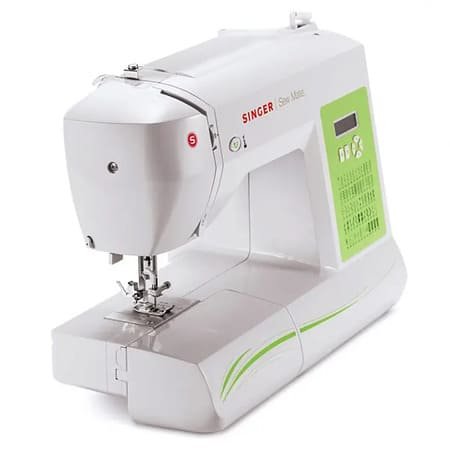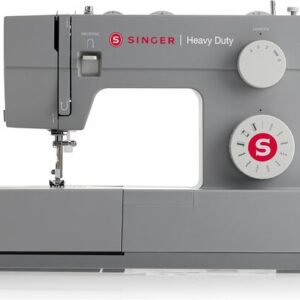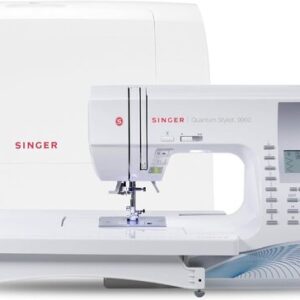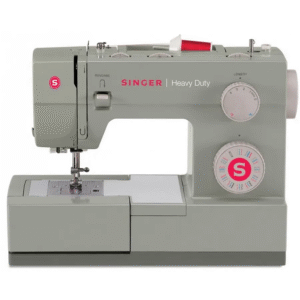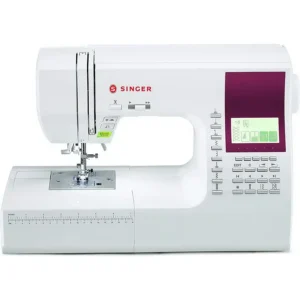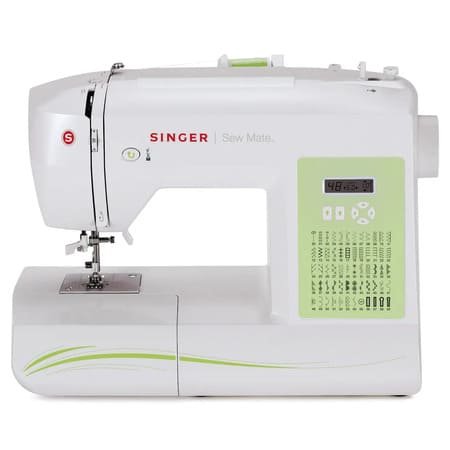
Singer Sew Mate 5400 Reviews Revealed – Real-World Test & Tips
$159.99 $179.99
Falling in love at first click
I had been using a clunky metal machine from the 1980s, and every hem felt like a wrestling match. One rainy Saturday I typed beginner-friendly sewing machine into the search bar. Page after page of Singer Sew Mate 5400 reviews popped up — some glowing, some grumpy, all intriguing. The price looked kind, the turquoise accents looked happy, so I pressed Add to Cart.
Two days later a neat white box landed on my doorstep. I brewed tea, opened the carton, and met the Singer Sew Mate 5400 for the first time. It was lighter than my old tank, but it didn’t feel flimsy. I plugged it in, let the LED glow for a second, and popped in the DVD that comes in the package. The presenter threaded the machine in slow motion; I copied every move and felt like a pro before I’d sewn a single stitch.
Our honeymoon stitches
The built-in needle threader was the first magic trick. After three tries it clicked, and the thread slipped through the eye like it had a mind of its own. I sewed a line across scrap cotton — perfect, even, no skipped spots. The next test was a buttonhole. I slid the button into the clever little foot, pressed the pedal, and the machine stitched a perfectly sized doorway in under thirty seconds. I honestly cheered out loud.
With confidence soaring, I made a rainbow skirt for my niece and repaired my partner’s torn jeans. Thick seams? No problem as long as I guided the fabric gently and used the right needle. By the end of week one I felt like I’d traded my old flip phone for a smartphone—and wondered why I’d waited so long.
The first argument
Every relationship has bumps, and ours came halfway through quilting a baby blanket. The screen flashed the dreaded “C4” error and the motor growled. I lifted the fabric to find a bird’s-nest of thread in the bobbin area. My heart sank; dozens of Singer Sew Mate 5400 reviews had warned about bobbin tantrums.
I took a breath, re-read the manual, and discovered I’d loaded a plastic “universal” bobbin instead of the recommended metal one. I swapped it, rethreaded from scratch (this time feeding the thread through the take-up lever from left to right—an online tip), and the snarling stopped. Lesson learned: metal bobbins only, and patience always.
Growing pains and quick fixes
Over the next months I logged serious hours on the 5400:
- Velcro on a utility vest – needed a size-16 needle and slow speed, but it worked.
- Two dozen cotton masks – the machine hummed for hours without overheating.
- Quilted potholders – the thick batting asked for a walking foot (bought separately), yet the stitches stayed even.
Not everything was rosy. I snapped two needles when I forgot to reset from a zigzag to a straight stitch, and once the auto-threader lever popped off when I tugged too hard (a dab of superglue fixed it). But every hiccup taught me more about tension dials, presser-foot pressure, and how to “listen” to the motor.
Why I’m still keeping it
A year later the Singer’s plastic paint is scuffed in places, but the internal timing is true. I adore the slide-off accessory tray — perfect for hemming sleeves—and the icons on the stitch panel still make sense at a glance. Could I upgrade to a heavier, quieter machine? Sure. Do I need to? Not yet.
For beginners, hobbyists, or anyone who sews on weekends rather than every single day, this model feels like that reliable friend who won’t judge your crooked first seam and will cheer when you finish your first dress. Yes, you must treat it well: use the right bobbins, clean lint often, and keep an eye on thread quality. Do that, and it will repay you with smooth stitches and creative freedom.
The bottom line
If you’ve skimmed a dozen Singer Sew Mate 5400 reviews and still can’t decide, here’s my nutshell:
It’s affordable, forgiving, packed with stitches, and light enough to carry to class. It can be temperamental if you ignore basic maintenance, but show it respect and it sings.
Now, if you’ll excuse me, I have a denim jacket begging for custom embroidery — and my Singer Sew Mate 5400 is already threaded, waiting for the next story we’ll sew together.
Singer Sew Mate 5400 Handy Sewing Machine
Pros and Cons of the Singer Sew Mate 5400 based on other Customer Reviews
| 👍 Pros (What people like) | 👎 Cons (What people complain about) |
|---|---|
| Budget-friendly price—many owners say you get a good feature set for well under $150. | Quality-control issues—a noticeable number of units arrive DOA, jam on first use, or show the “C4” error. |
| Beginner-friendly setup—DVD, YouTube guides, clear stitch icons, and lightweight body make it unintimidating for first-timers. | Bobbin & tension troubles—frequent reports of bird-nesting, skipped stitches, loose top tension, and plastic bobbins popping out unless replaced with metal. |
| Automatic needle threader & one-step buttonhole—big hit with users who have poor eyesight or hate hand-threading. | Fragile threader & plastic parts—the auto-threader lever and other small pieces break easily if handled roughly. |
| 60 built-in stitches—decoratives, stretch, and utility patterns give hobby sewists room to experiment. | Struggles with thick fabrics—several Singer Sew Mate 5400 reviews note it stalls on denim, canvas, or multiple bulky layers. |
| Good stitch quality on light/medium fabrics—owners mention straight, even seams for masks, baby clothes, pillowcases, and quilts. | No top-loading bobbin / front-load tray—extra step of removing the storage compartment frustrates some users. |
| Portable & lighter than older metal machines—easy to carry to classes or store in a closet. | Loud motor start-up & vibration—a minority feel it’s noisier than comparable Brother models. |
| Helpful online community—lots of fix-it tips (e.g., reversing the take-up-lever threading) keep some machines running. | Spotty customer service / repair network—users outside the U.S. or far from an authorized center struggle to get warranty help. |
| Versatile for everyday household tasks—hemming pants, altering curtains, crafting masks, basic quilting. | Not pro-grade—veteran sewists say it’s “light duty” and unsuitable for heavy daily or commercial work. |
Read more Verified Customer Reviews
COMPARE Singer Sew Mate 5400 TO SIMILAR MODELS
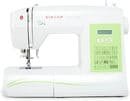 Singer Sew Mate 5400 Handy Sewing Machine |
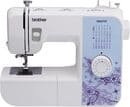 Brother XM2701 Sewing Machine |
 SINGER M1150 Lightweight & Portable Sewing Machine |
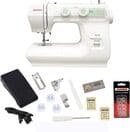 Janome 2212 Sewing Machine |
|
| Check Price at: | ||||
| Built-in Stitches | 60 | 27 | 15 | 12 |
| Buttonhole Style | 4 One-step automatic | 1 One-step automatic | 1 Four-step manual | 1 Four-step manual |
| Automatic Needle Threader | Yes | Yes | No | No |
| Adjustable Stitch Width | Yes (up to 6.0 mm) | Yes (up to 5.0 mm) | No (preset) | Yes (up to 5.0 mm) |
| Adjustable Stitch Length | Yes (up to 4.0 mm) | Yes (up to 4.0 mm) | No (preset) | Yes (up to 4.0 mm) |
| Free Arm | Yes | Yes | Yes | Yes |
| Thread Cutter | Yes | Yes | Yes | Yes |
| Presser Feet Included | 4 | 6 | 3 | 4 |
| Bobbin Type | Front-loading | Top drop-in | Top drop-in | Front-loading |
| Stitches Per Minute (SPM) | 750 | 800 | 750 | 860 |
| Dimensions (W x D x H) | 16.5″ x 8.0″ x 12.5″ | 12.1″ x 5.9″ x 15.3″ | 12.6″ x 5.9″ x 16.1″ | 17.0″ x 9.0″ x 13.5″ |
| Weight | 17.5 lbs | 12.6 lbs | 10.4 lbs | 13.2 lbs |
| Best For | Versatile home sewing with decorative stitches | Beginners needing simplicity + features | Absolute beginners | Beginners wanting manual control |
| Warranty | 25-year limited | 25-year limited | 25-year limited | 25-year limited |
Summary:
- Singer Sew Mate 5400: Best for users wanting a variety of stitches and features at a mid-range price.
- Brother XM2701: Excellent value with user-friendly design and more accessories.
- Singer Start 1304: Simplest option — great for young beginners or quick mending.
- Janome 2212: More traditional feel with manual controls and strong stitch quality.
SINGER Sew Mate 5400 – Frequently Asked Questions
What accessories are included with the Singer Sew Mate 5400?
Every fresh Singer Sew Mate 5400 ships with a starter kit that covers almost every basic task: needles, Class-15 bobbins, an auxiliary spool pin, felt discs and a spool cap to keep thread feeding smoothly, a seam-ripper/brush combo, a screwdriver for the needle plate, a darning plate, a zipper foot and a one-step buttonhole foot. The all-purpose zig-zag foot comes pre-installed.
How many stitches does it have?
The machine’s computer gives you 60 built-in stitches, including utility straight and zig-zag, stretch options, 40-plus decorative designs and four fully automatic one-step buttonholes—plenty for quilting, repairs or creative décor, as detailed in the Singer Sew Mate 5400 review pages of the manual.
Does it really have an automatic needle threader?
Yes. Flip the small lever beside the needle bar and the built-in threader catches the thread and pulls a loop through the eye—no squinting required. It’s shown as part 21 on the parts diagram.
What’s the correct way to wind and insert the bobbin?
Use Class-15 bobbins. Pop the spool on top, guide the thread into the tension disk, push the winder right and the 5400 stops automatically when full. Drop the bobbin into its case with the thread running clockwise, snap it into the shuttle, then pick up the lower thread exactly as shown in the manual.
Can it sew buttonholes automatically?
Absolutely. Choose the buttonhole pattern, drop your button into the special foot and the Singer Sew Mate 5400 measures and stitches a perfectly sized hole in one pass—no manual measuring needed.
Does the bed convert to free-arm?
Yes. Slide off the accessory table and the narrow free-arm lets you hem sleeves, cuffs or kids’ clothes with ease—ideal for circular seams.
Which needles and threads should I use?
Follow the fabric chart: light cottons use size 11/80 needles, medium wovens size 14/90, heavy denim size 16/100 and knits a yellow-shank 2045 ball-point, matched with quality all-purpose polyester or cotton-wrapped thread for smooth results.
How do I adjust top thread tension?
Start at the factory setting 5. If top stitches look loose, turn the dial up; if bobbin thread pulls to the surface, dial down. Most Singer Sew Mate 5400 reviews note only small tweaks are needed.
What basic maintenance does the 5400 need?
After every project, unplug, remove the bobbin race cover, brush out lint and add one drop of sewing-machine oil to the hook. Keeping feed dogs and the foot control clean prevents skipping—simple TLC that many positive Singer Sew Mate 5400 review posts highlight.
How heavy is the machine and what power does it use?
The unit weighs about 6.6 kg (14.5 lb) and draws 65 W from a standard 230 V 50 Hz outlet (US models are 110 V). It stays below 70 dB, so it’s fairly quiet on a sturdy table.
Is it safe for beginners and kids?
The manual lists full safety rules: always unplug before maintenance, keep fingers away from the needle, and supervise younger users. Treated with respect, the 5400 is beginner-friendly—a point echoed in many Singer Sew Mate 5400 reviews.
Where can I find troubleshooting messages?
Page 29 shows ‘Helpful Messages’—error codes that pop up on screen and tell you if the presser foot is up or the bobbin is jammed, a quick reference that can prevent the frustrations some users mention in their Singer Sew Mate 5400 review.
| Specification | Details |
|---|---|
| Model Name | Singer Sew Mate 5400 Handy Sewing Machine |
| Stitch Applications | 60 Built-in stitch patterns |
| Stitch Width | Adjustable up to 6.0 mm |
| Stitch Length | Adjustable up to 4.0 mm |
| Buttonhole Type | 4 Fully automatic 1-step buttonhole styles |
| Needle Positions | Multiple positions (adjustable needle position for straight stitch) |
| Free Arm | Yes (for sewing cuffs, sleeves, etc.) |
| Automatic Needle Threader | Yes |
| Presser Feet Included | All-purpose foot, zipper foot, buttonhole foot, button sewing foot |
| Bobbin Type | Front-loading bobbin system (metal bobbin recommended) |
| Voltage (EU version) | 230V ~ / 50Hz |
| Voltage (US version) | 110V ~ / 60Hz |
| Rated Power Input | 65 Watts |
| Machine Dimensions | 37.6 cm (W) × 19.7 cm (D) × 30.1 cm (H) |
| Weight | 6.6 kg (approx. 14.5 lbs) |
| Noise Level | Less than 70 dB(A) |
| Recommended Use | Domestic sewing, beginner to intermediate level |
| Additional Features | Adjustable thread tension, reverse stitch button, decorative and stretch stitches |

